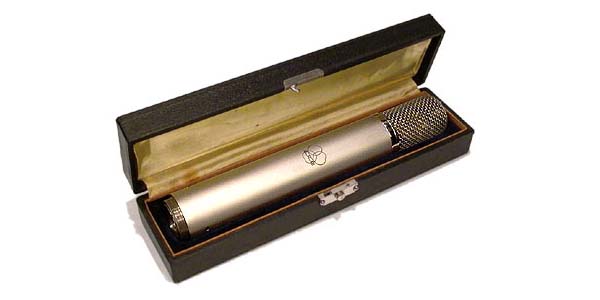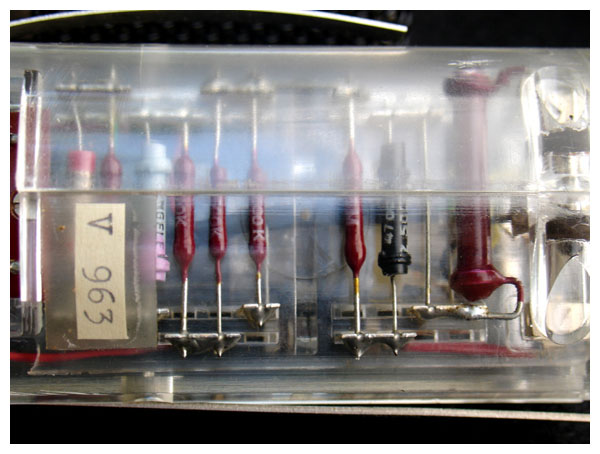
The AKG Model C 12
multi-directional condenser microphone

The AKG C 12 is a studio condenser microphone of the highest professional quality. It has been specially designed for use in sound recording and broadcasting studios, and is the choice of many studios both at home and abroad.
Nine different directional characteristics can be selected by means of a remote control unit without any change in frequency response or sensitivity. In addition to three basic characteristics, omni-directional, cardioid and bi-directional, six intermediate patterns (including hypercardioids) are available. The S 12 control unit is connected to the N 12 power supply unit by the RL 12 remote control cable, and the power supply unit to the microphone by the MK 12 mic cable.


Technical Data
- Frequency Range: 20 to 20,000 cps
- Frequency Response: ± 2 dB related to published curve
- Directional Characteristics (nine different positions): omni-directional.
Cardioid: better than 20 dB front-to-back ratio at 180° sound incidence,
bi-directional: 20 dB front-to-back ratio
- Sensitivity: 1.0 mV/µbar (–60 dB re 1 V/dyne/cm2), unloaded (200 ohms)
- Equivalent Noise Level: less than 20 dB
- Impedance: 50/200 ohms (change solder lugs)
- Tube Complement: 1 x 6072, 6.3 volts DC filament voltage,
120 volts DC plate voltage
- Mains Connection: 110/125/145/220/245 volts AC at 50/60 cps
- Stand Connector: 3⁄8", ½", 5⁄8"-27 with microphone cable MK 12
- Dimensions: 10" (255 mm) with connector, 11⁄16" diameter (43 mm)
- Weight: 1 lb. 3.2 oz. net (560 g), shipping weight 29 lbs. 12.8 ozs. (13.5 kg)

The AKG C 12 was introduced in 1953 and production continued until 1963. The C 12 was the world’s first remote-controllable multi-pattern large-diaphragm microphone, and about 2,500 of them were produced during its ten-year run. OEM versions of the C 12 were also produced for Siemens (SM 203, SM 204) and for Telefunken (ELA M 251).
February 2008 update, thanks to Mr. Holger de Buhr: “The truth is that the first remote-controllable multi-pattern large-diaphragm microphone was the M 49, originally designed by the Nordwestdeutsches Rundfunk, Hamburg, in 1949 (early postwar German state broadcaster, later NDR and WDR). The first M 49 mics were manufactured with M 7 capsules, and Mayhak Hamburg power supplies were used. Later the M 49 used K 47 capsules and Neumann Berlin power supplies.”

The AKG C 12 is considered “the holy grail” of microphones by audio engineers for its beautiful three-dimensional vocal quality—a result of the combination of its hand-tensioned, edge-terminated AKG capsule and the rare GE 6072 triode tube. Original C 12s regularly sell for $10,000 to $15,000 and some have fetched upwards of $30,000—many times their original price (even factoring inflation) thanks to its combination of rarity and high performance. The unit shown in these photographs was won on eBay for $6,862 on October 23, 2005. The C 12 is still influencing the art of large-diaphragm condenser recording microphones more than fifty years after its introduction. Its CK 12 capsule was the first to have the acoustic “fingerprint” in its frequency response for which other AKG microphones have become famous: a small dip at around two kHz and a well-chosen presence rise.
The Telefunken Models ELA M 250, 251
multi-directional condenser microphones
The following photographs and schematics are provided through the courtesy of John Warshaw.




Mr. Warshaw writes:
The Telefunken ELA M 250/251 was made for Telefunken by AKG after Neumann discontinued its OEM production of the Telefunken U 47. Of course Neumann still made the U 47 for many years. Telefunken needed a quality condenser, and AKG stepped in.
The differences between the C 12 and the ELA M 250 are small but important. The C 12 is remotely controlled for pattern by polarizing the rear diaphragm with a separate variable voltage from the power supply, while the ELA M 250/251 has switches in the capsule assembly that change its polarization pattern. The 250 has two patterns, Omni and Cardioid. The 251 included these patterns and also the figure eight.
The second difference is in the circuit. The C 12 and ELA M 250 circuits are similar but not identical. They both use the CK 12 capsule, T/14 transformer and either the 6072A tube (US version) or the AC701 (Europe), but the grid coupling, cathode bias and capsule polarization are different.
Third, the body style of the C 12 and ELA M 250 are not the same. Most important, the head grilles are different, so acoustics are also different.
The photo of the black mic is not an AKG model but was made by an east German company by the name of Thiele, a rather unknown brand from the forties and fifties. I bought this on ebay five years ago and rewired it in the spirit of the ELA M 250. It works great and I have used it on the KPIG live radio shows on Sunday mornings with Sleepy John.







Download a description of the original C 12
(German and English)